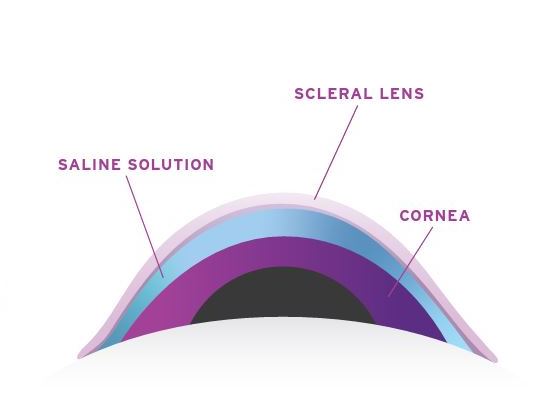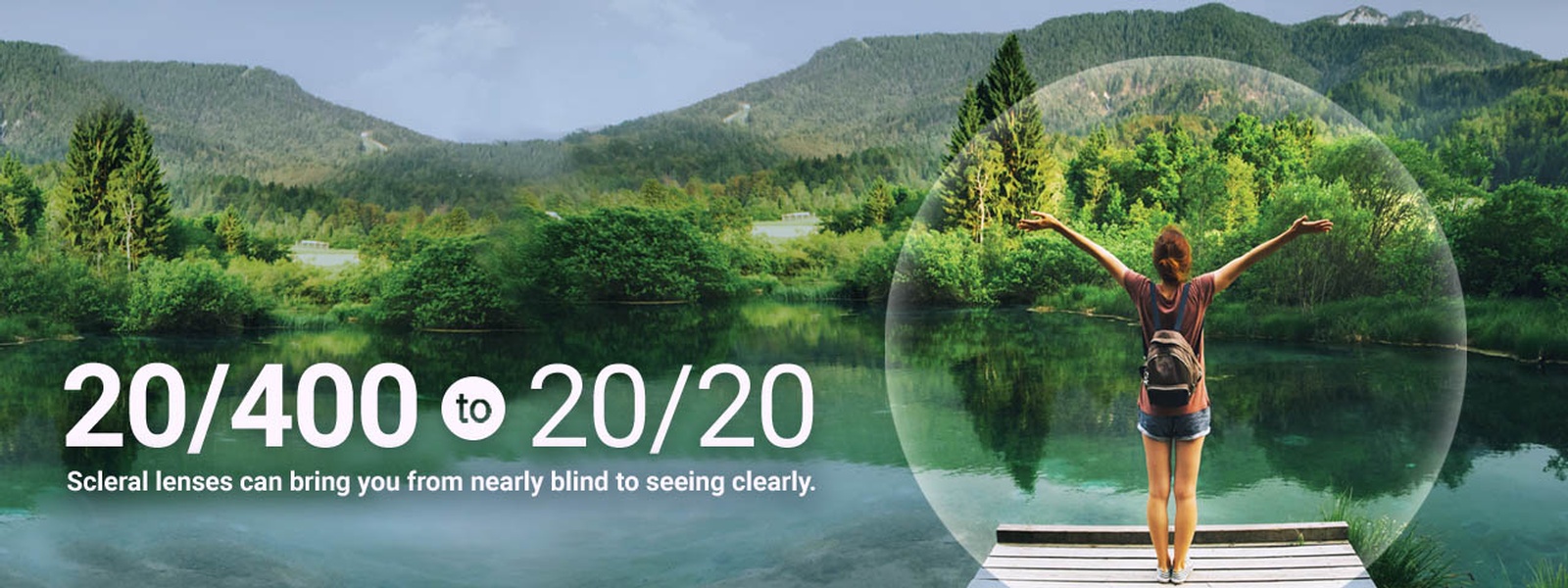Scleral lenses are a great option for just about everyone!
A sophisticated lens design for reliable vision and unsurpassed comfort. A contact lens capable of eliminating irregularities found on the front surface of your eye, correcting your vision for distance, near and everything in between!
Scleral lenses are designed using sophisticated curves to create a tear layer between your eye and the lens.
They are designed to vault the entire corneal surface, including the limbal area, then gently rest on the conjunctiva.
The space between the cornea and the back surface of this lens is filled with tears, which help neutralize the irregularities on the cornea’s surface while continuously hydrating your eye for unparalleled comfort and consistent vision.
Confusing, we know….
This is a large RGP lens (rigid gas permeable material) and similar in size to a soft contact lens.
The Scleral lens forms a dome or a vault over the colored part of your eye (over the cornea itself) and lands on the white part of your eye, which is a non-sensitive area.
This dome is filled with fluid (tears and saline), so your eye remains bathed in a layer of tears.


Who can wear a scleral lens?
scleral lens users are a diverse community! We end up in scleral lenses for all different reasons and at all different times of life! From young children to age 90+!
You may be motivated by VISION loss, ocular surface DRYNESS or exposure, or PAIN, or a combination of factors.
You may never have worn any type of contact lens before. Or maybe you’ve worn every contact lens before.
You may have a corneal disease or dystrophy, or suffering from Sjogren's Syndrome, Stevens Johnson Syndrome, Herpes Zoster, keratoconus or Pellucid Marginal Degeneration (PMD).
You may have exposed corneas because of an eyelid surgery or possibly have Graft-v-Host Disease from a transplant.
You may have "garden variety" dry eye or Meibomian Gland Dysfunction (MGD). You may have vision complications from an eye surgery such as RK, PRK or LASIK.
You may have had a corneal transplant or two (or three)!
These are just some of the many examples. Your doctor may have recommended scleral lenses,or you may have found them by doing your own research. Your cornea specialist may have referred you, or you may have sought out a fitter on your own.
Maybe you’re interested in being fitted with a scleral contact lens because of all of these other potential reasons…
- Needing help near vision, especially if you have astigmatism or dryness.
- Post Lasik or RK procedures and now need vision correction.
- Keratoconus and other irregular cornea conditions such as moderate to severe ectactic corneas and Pellucid Marginal Degeneration.
- Protection against environmental hazards such as wind, dust, debris and allergens.
- Peace-of-mind that your eye is protected, and your lens isn’t going anywhere-making them a reliable option for athletes and active individuals.
- You have complicated eyes due to pingueculas, growths or shunts.
- Experiencing dryness symptoms or Ocular Surface Disease.
- Experience discomfort or unable to adapt to regular contact lenses.

Treating Dry Eye with Scleral Lenses
One of the most promising techniques for ALLEVIATING the pain caused by dry eye is the scleral lens.
Scleral lenses can help with persistent dryness, scratching and burning in the eyes. Regular contact lenses don’t provide clear vision for more than a limited amount of time and almost always exacerbate their struggle with dryness.
Many patients have had an improvement in their vision and quality of life because of scleral lenses.
Some other possible reasons as to why you may have dry eyes and benefit from wearing a scleral contact lens:
- The natural aging process.
- Ocular Surface disease.
- Caused by medications such as antihistamines, oral contraceptives, antidepressants and blood pressure medications.
- Living in a dry, dusty, windy climate may also cause dry eye.
- Insufficient blinking such as when you are staring at a computer screen all day.
- Dry eyes can also be a result of systemic diseases like Rheumatoid Arthritis, Rosacea, Sjogren’s Syndrome and Lupus.

Not all Scleral lenses are designed or fitted equally
With the advent of fully customized lenses, the clearance over the cornea can be fully customized, optimizing the oxygen transmission to the tissue, especially over the limbus where the stem cells are located.
Current studies indicate that the fluid layer found between the lens and the cornea is an important concern.
If this fluid layer is excessively thick, it can deprive the cornea and the stem cells of oxygen. If this fluid layer is not sufficient, it can cause the lens to weigh on the extremely sensitive tissue, potentially causing damage to the epithelial cells.
Wearing scleral lenses requires a great deal of responsibility, by you and the contact lens practitioner. You must be diligent in following proper cleaning routines and wearing schedules.
We will continually monitor your eyes while wearing these custom lenses in order to avoid potentially serious contact related complications.
Our specialty lens program is designed with these concerns in mind. We will provide as many assessments needed to ensure the comfort, vision and health of your eye is maintained.

WHY do I need to have a consultation appointment?
The process for fitting specialty contact lenses is complex. Special computerized instruments—such as corneal topographers—are usually necessary to obtain accurate measurements of the irregular corneal surface.
These measurements allow a contact lens practitioner to obtain the best possible fit and level of vision correction.

The corneal topographer has revolutionized corneal shape analysis! These instruments project a series of illuminated rings onto the cornea, measuring hundreds and even thousands of data points to build a much more precise map of the eye.
Knowing the exact shape of your cornea is extremely important. The maps display a 3-dimensional image that allows us to get a better understanding of what may be occurring with the cornea and how to work with it.


